Planting roses: growing and caring for a rose garden
Use our guide to planting roses to find out how to plan and grow a beautiful rose garden, whatever the size of your plot
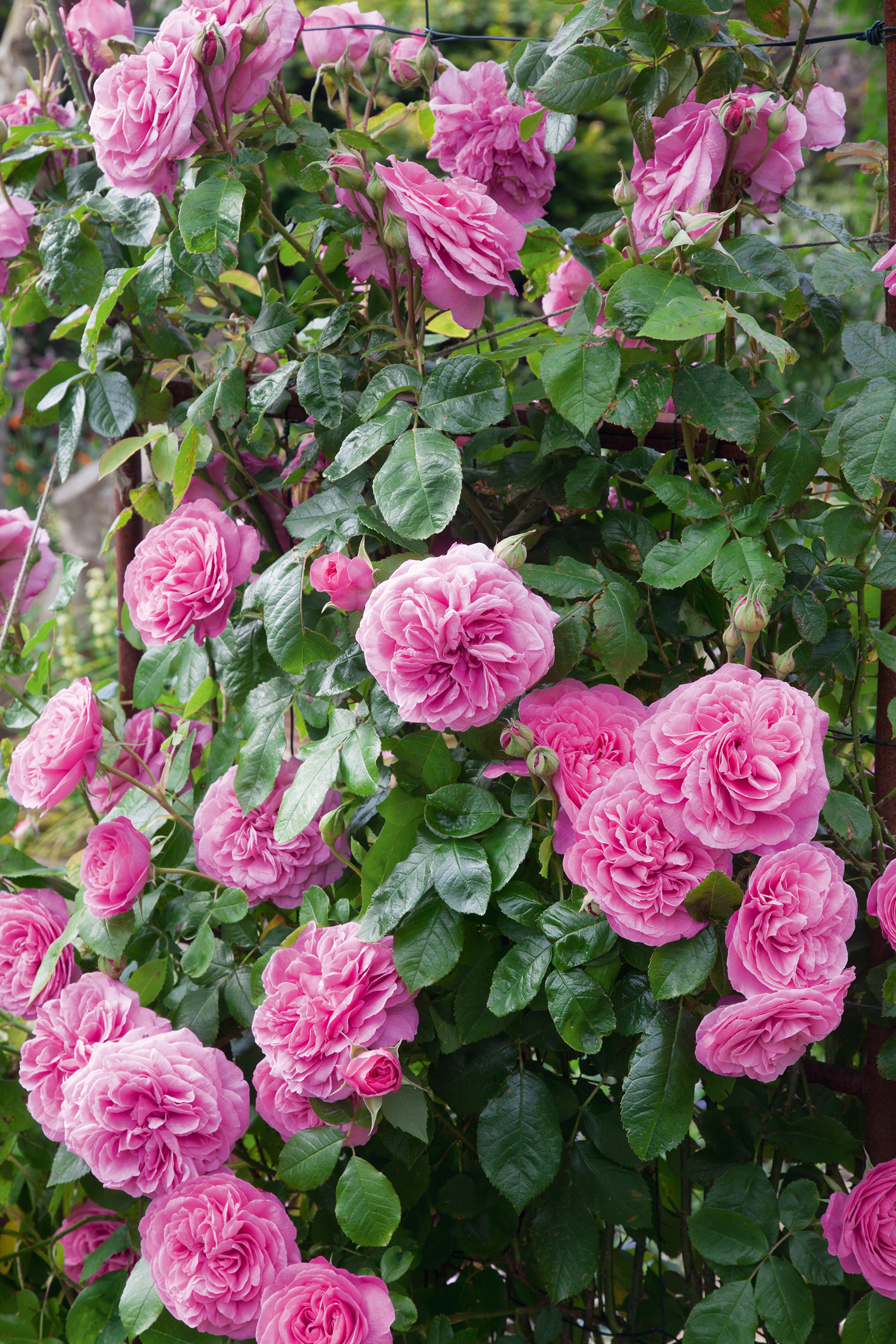
Planting roses is perfect for creating a quintessential, romantic English garden – and they are one of the most versatile plants for any setting. With their classic beauty and heady scent, is it any wonder these ‘queen of flowers’ are perennially popular?
You can incorporate roses into your garden planting scheme whatever its size or style – whether traditional or contemporary. With their wide variety of of colors, sizes and growth habits, roses can blend in as part of a cottage garden style, add elegance to formal beds, drape over arches and walls, or be planted in patio containers.
Thinking of incorporating a rose garden into a new garden design? Read on to find out how to plan and design your rose garden, as well as suggested rose varieties to try.
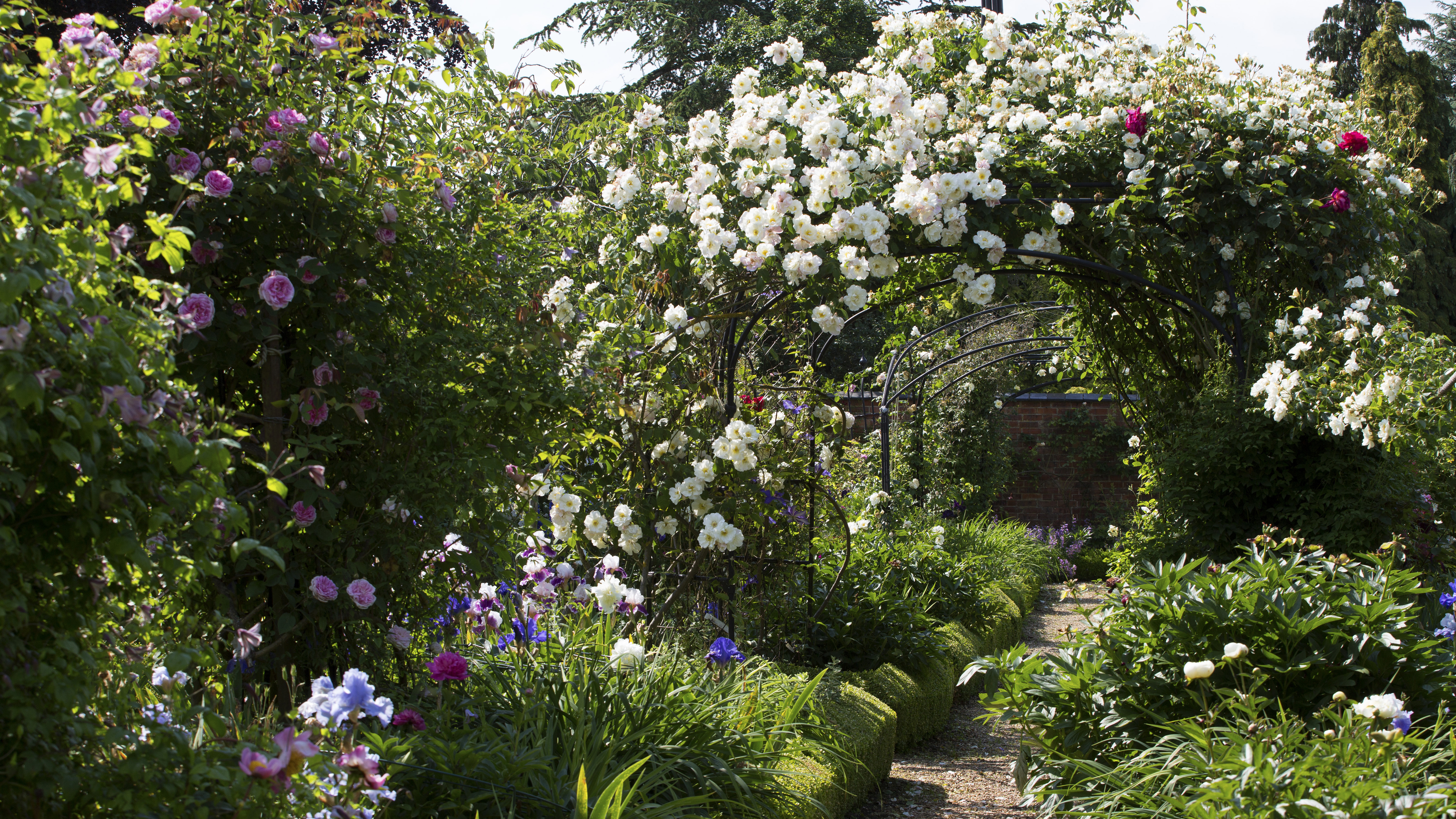
Climbing roses are perfect for training over pergolas and arches
Planting roses: make a plan for a rose garden
Provide roses with the right growing conditions and you'll be rewarded by the results. Planting a beautiful rose garden needs careful planning. Begin by assessing your garden's micro-climates and conditions.
There are so many different varieties available that it is possible to select ones for nearly any location in the garden. Most, however, prefer any open, sunny site, and well-drained soil.
Decide colors and style of flowers to suit your taste, the style of your house and garden, the conditions, and what effect you are aiming to create. Ideally try to see roses in bloom by visiting specialist nurseries and rose gardens during the flowering season.
Decide whether you want roses on their own, or mixed with herbaceous plants or shrubs. If you want to plant roses in containers, find more advice and ideas for container gardening.
Get small space home decor ideas, celeb inspiration, DIY tips and more, straight to your inbox!
Top planting tips:
- Prepare the soil: Roses will grow in most well-drained soils, but incorporate some well-rotted compost or manure before planting. If this doesn't sound like your plot, you might want to grow them in a raised bed or large pot where you can control the soil type and enhance drainage. Dig in plenty of manure before planting to prepare your soil.
- Sunlight: The majority are fully hardy and prefer a sunny position – although will do well if they get five or six hours of sun a day and are placed in an open position. There are shade-loving roses such as David Austin's Princess Anne and Phyllis Bide (see more roses for shady areas on the David Austin site). If planting in a hot or Mediterranean climate, make sure they have partial shade to avoid scorching.
- Sheltered/protected spots: Although they need good sun, don't plant your roses anywhere where they will be exposed to high winds or extreme frosts. A sheltered spot with good light is the best place (think south-facing with some large structures nearby to act as wind breaks).
- Growing roses together: Deciding how many roses to grow in a space will depend on the type and growth habit – for instance, old roses need more space. Always research the roses you'd like to grow beforehand to ensure optimum results.
- Planning flowering seasons: If you choose rose varieties that repeat flower in flushes from June to the first frosts, this allows a succession of combinations with your annuals and perennials that also keep blooming, such as phlox, lilies, penstemons and salvias.
- Companion planting: Roses need plenty of moisture so planting them in crowded places will mean they have to compete. They could also get overshadowed by other plants and not get the sunlight they crave. Plant your roses 1m away from other plants and 60cm or more from other roses. For an arch like the one pictured above, this could mean planting a climber at 60cm intervals along the vertical struts. See more on companion planting below.
- Thinking budget: The most economical way to grow roses is to plant bare-root plants from late autumn to early spring. Water well until established and feed often in spring, followed by mulching with organic matter to retain moisture and suppress weeds – but not close to the stems. Bare root roses are generally the best quality, have a wider spread of roots than container plants, and should be planted out as soon as you receive them.
Recommended rose breeders with mail order websites include:

Planting a formal rose garden
Planting roses for a formal rose garden involves designing a series of beds and interesting paths; keep in mind that more beds mean more maintenance.
Plan a geometric layout of square, rectangular or round beds, but keep the design simpler for smaller spaces. Enclosed beds edged with low, neatly clipped hedges of box, myrtle or privet, are a classic choice. The hedges will hide the bare earth and lead the eye straight to the flowers.
Rose Groups

Roses derive from around 100 species, with thousands of cultivars now to choose from. The array on offer can get a little complicated and bewildering, so think of roses in three main groups:
Species or wild roses – mostly single flowered that like to sprawl in a natural style, many have colourful hips in autumn; includes rugosa, glauca, moyesii and canina.
Old Garden Roses – dating from before the 1860s, these large graceful shrubs with mostly one flowering are richly fragrant; includes alba, gallica, damask, cabbage and moss roses.
Modern Roses – bred from the early 20th century, these repeat-flowering varieties include floribundas, hybrid teas, landscape, climbers, miniature and David Austin English roses, which combine flower and fragrance of old roses with wider colours and repeat flowering of the new.
Shrub and modern roses are ideal choices, as are standard roses. For a strictly formal garden design include roses alone, carefully positioned, planted quite close together and mulched, then trained and trimmed to conform to the design.
For a more casual touch, underplant roses with a controlled colour scheme of shallow-rooted annuals, perennials or tiny bulbs. If the plants chosen are lower than the rose bushes, their roots will not compete, and the formal look won’t get lost amid a tangle of growth.
Use our guide to choosing plants for your garden to get more advice.
An elegant focal point of an urn, statuary or a water feature will complete the scene. Large pots of standard roses could punctuate each bed or be placed at regular intervals along the framework.
To add an element of height, include climbers, arbors, pillars or tunnels, and position seating to enjoy the scene through summer. Read our guide to creating a vertical garden for more design advice.

Roses clambering up an old stone garden wall around an archway – does it get more dreamy than that?
Planting roses with companion plants: which work well?
Including some pretty companion planting around the roses looks pretty and can help to keep down pests and disease. For instance, feverfew draws aphids, marigolds and chives repel pests and insects, and garlic protects from pests and helps prevent fungal diseases.
A fringe of lavender as hedging or as a ribbon of colour inside the low hedges will soften the rigidity of a formal rose garden design and could be echoed by planting around a central focal point.
Topiary is another perfect companion and will provide structure when the roses aren’t in flower.
For a uniform look, try one kind of ground cover.
Perfect pairings:
- Sprinkle the area beneath the roses with alyssum or dwarf Virginia stock seeds for a do-it-once solution, as these frothy annuals will self-seed.
- White erigeron and alyssum make a good foil for colourful roses.
- Silver or grey ground covers, such as cerastium, look elegant in a formal scheme.
- Iceland poppies under roses fill the space with colour in early spring, and then the roses come back into bloom.
- To keep interest over a long season, underplant the roses with low-growing spring bulbs, such as grape hyacinths or scilla, which will flower when the roses are not at their best.
- Alchemilla mollis makes soft mounds under the bases of roses, adding texture.
- Underplanting with alliums or salvias acts as a natural fungicide, keeping roses healthy
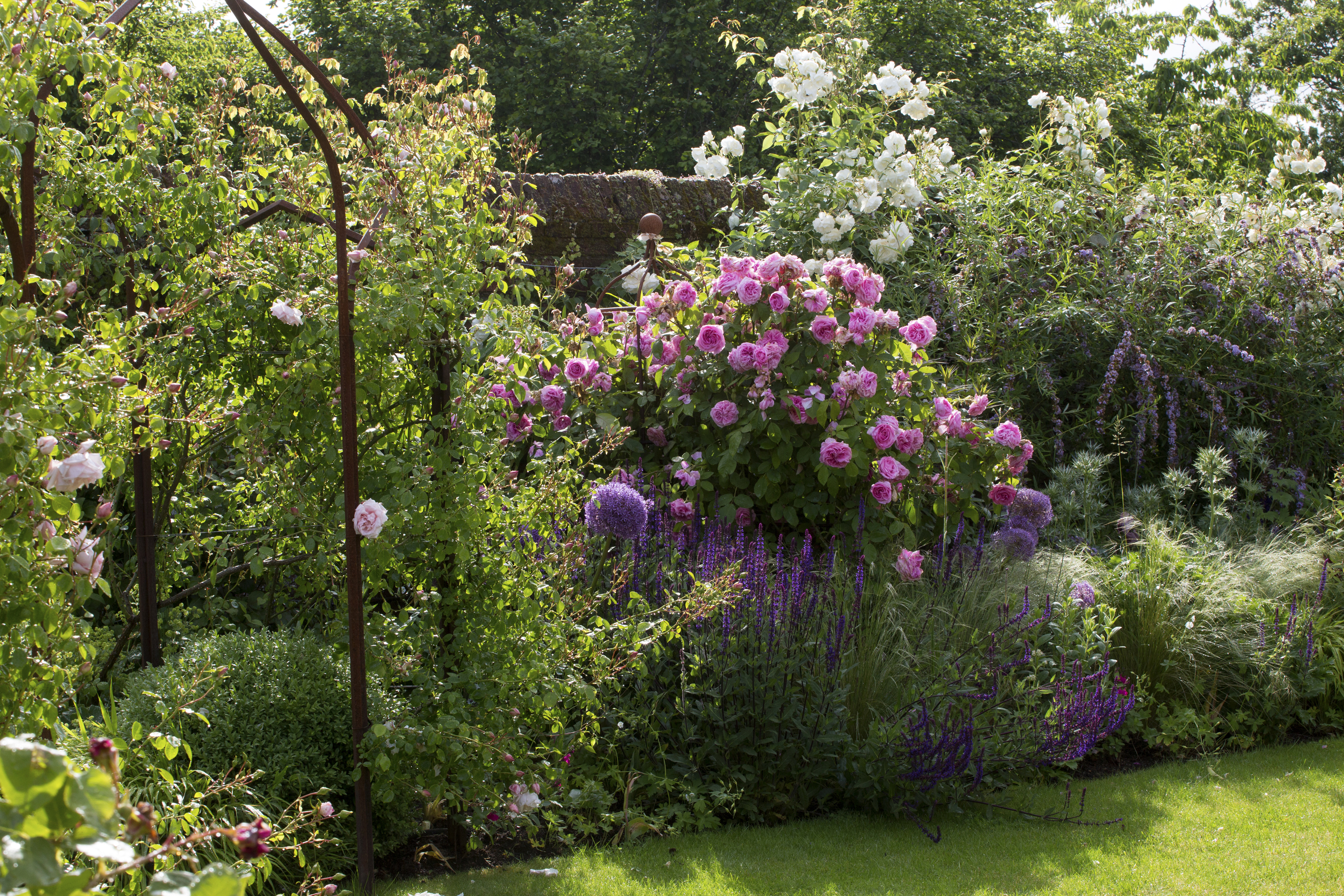
Roses can be incorporated in among other plants in garden borders
Planting an informal rose garden
If you’d like to mix roses in borders and beds for an informal, cottage garden style, interplant with low shrubs, bulbs, climbers, annuals and perennials that like the same amount of sun and water.
Consider the colours, textures and shape combinations and ensure there is still good air circulation around the roses. The trick is to plan a succession of interest from flowers and foliage.
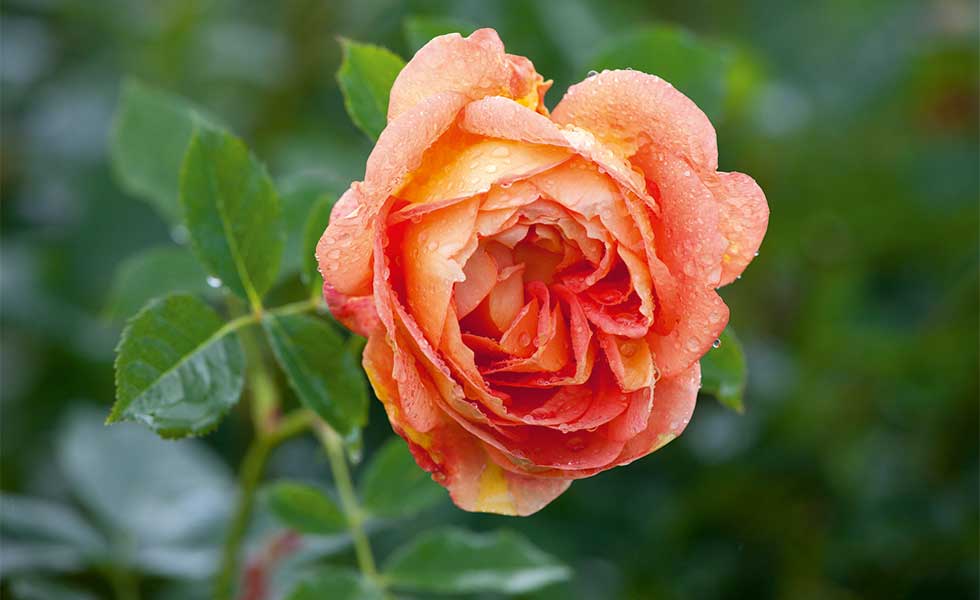
Rosa ‘Lady of Shalott’
Think about when the roses are in flower and when they are not and you want to camouflage bare stems.
Companion flowers that bloom at the same time and are classic choices include geraniums, peonies, forget-me-nots, delphiniums, irises, poppies, lavender, nepeta, campanula, lupins and clematis, poppy and ornamental grasses.
Find more gardening inspiration in Period Living Magazine
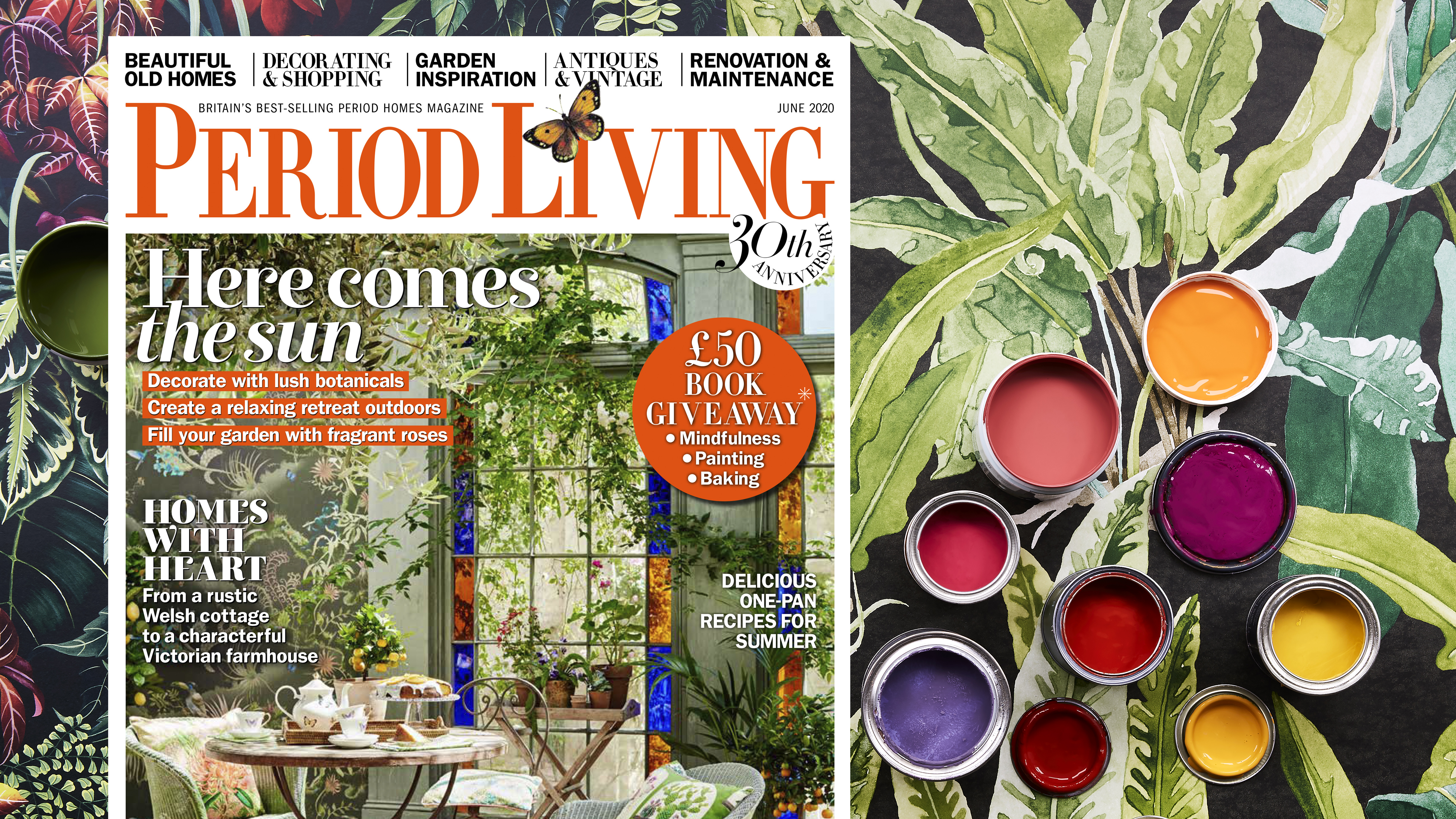
Period Living magazine is the perfect source of inspiration for anyone who owns an older property, or just loves characterful style. Check out the latest subscription offers.
The most romantic roses for an informal rose garden are ones with a wild habit. There is an array of cupped, fragrant old-fashioned-looking options, many of which are actually modern, such as the English roses. Rather than being tightly pruned, they are allowed to grow into larger, more natural shapes.
For a long succession of flowers, include some spring-flowering floribunda that can bloom continuously from spring to autumn, or the prolific Rosa banksiae ‘Lutea’, which blooms spectacularly once in May with sprays of small primrose yellow flowers.
Follow your display with the first blooms in summer and second flushes late in the season, and add extra autumn interest from a few spectacular hip varieties, such as Rosa moyesii and the rugosas.
Complete the look with ramblers, which flower once, or repeat-flowering climbers on supports or arbors.

Features, such as bird tables or water features, can be used to create focal points within rose gardens
Pruning for healthy growth
All roses are resilient but you need to know when and how to prune roses properly to ensure they grow at a good rate and flower beautifully, year after year. Rest assured that a rose will not be killed by inappropriate pruning; the worst outcome is that it may not produce any flowers that year.
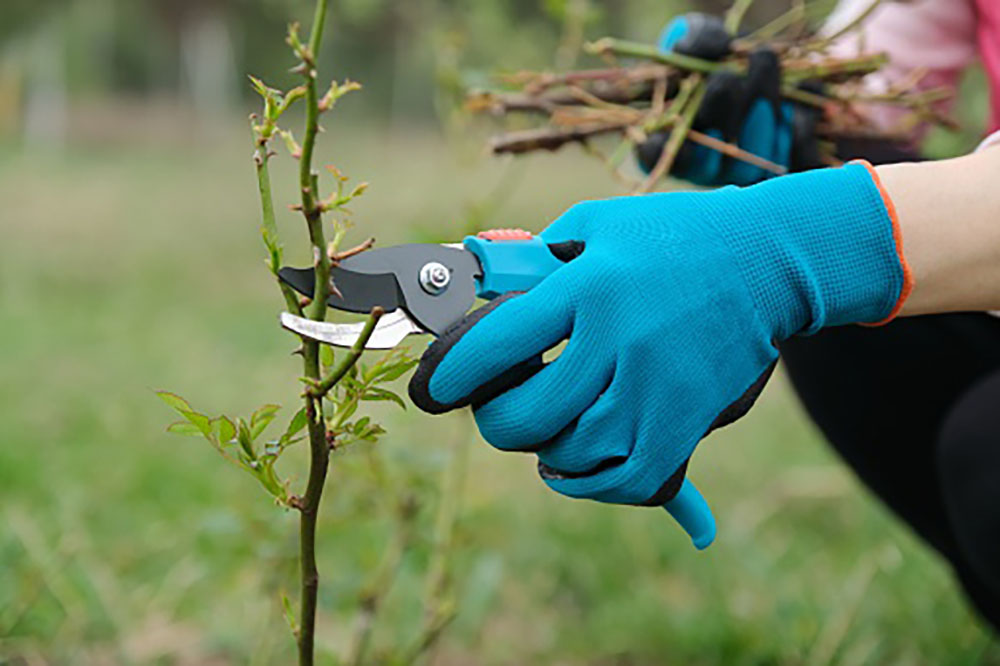
Removing a significant portion of the previous year’s (or even two years previous) growth helps direct the rose's energy, making way for new growth and for an even more stunning display come spring and summer. It’s an annual ‘event’ shall we call it, and in essence, pruning is a process of renewal that will allow your rose(s) to bloom bigger and better than ever. It's a must and it's simple to do.

Caring for your rose garden
Be vigilant with your maintenance. Tidy up any fallen leaves and keep your roses well fed and pruned to help them bloom to their best – use our garden maintenance checklist for more handy tips.
Don’t plant where roses have been before to prevent replant disease. If you have to spray there are organic options for aphids and thrips, but for some conditions you may need chemical sprays.
Regular feeding is essential for healthy roses and differs depending on the soil type:
Clay soil: feed twice a year in March and late June
Sandy and chalk soil: feed monthly throughout spring and summer
Loam: adopt a regime in between the above two
Aside from deadheading roses, never prune your plants in late summer or autumn as this could promote softer growth that would be killed off in frosts.
Water roses in the morning and keep the leaves dry to help prevent disease. If the soil is dry, water well, but avoid frequent, small amounts of water.

Expert advice from David Austin Roses
Michael Marriott, Senior Rosarian at David Austin Roses, offers the following advice for repeat-flowering varieties:
- Deadhead, especially varieties that set hips, as setting seed saps energy for flower production.
- Watering well can encourage flowering again.
- Hard pruning in late winter helps to encourage the roses back into action.
- Feed during or towards the end of the first flowering to boost another flush.
- Horizontal training of climbing roses encourages more flowers.
- Plant three of the same variety close together to form one fine shrub.
12 recommended roses

- ‘American Pillar’ – A very hardy, vigorous long-lived climbing rambler that is fast growing with glossy foliage. It blooms once spectacularly with dense sprays of flowers in midsummer, is best grown in full sun but tolerates some shade and is drought resistant. It has little fragrance, but it is a good choice for walls, arbours, or other structures -grow on its own or it will smother other climbers.
- ‘Darcey Bussell’ – A David Austin English shrub rose which is repeat-flowering with a fruity fragrance. With compact growth it is lovely in the border, in a dedicated rose garden, for hedging or in containers. The richly crimson full blooms look lovely with mauve nepeta and lime green Alchemilla mollis.
- ‘Constance Spry’ – This beautiful rose was the first of David Austin’s and introduced the myrrh fragrance to the English roses. Flowers once in early summer and has strong growth. It can be grown as a climber with easy to train flexible canes, making it ideal for fences, walls, trellises and pergolas. It is best in full sun but tolerates some shade.
- ‘Just Joey’ – An elegant, continuously flowering hybrid tea with large fragrant blooms of ruffled petals. Disease resistant and with attractive mahogany-tinted foliage, its compact habit makes it ideal as a border plant, massed together and in containers, while the blooms make good cut flowers as well. Ensure that it gets plenty of sunlight.
- ‘Nevada’ – Creamy white semi-double blooms, which open fully to show their deep yellow stamens, smother this shrub rose early in the season, and then it flowers intermittently through summer with showy red or purple fruits in autumn. Grows best in full sun and is tolerant of poor soils.
- ‘Peace’ – The classic hybrid tea known for its sweetly scented pink-flushed yellow double blooms, from late spring to autumn. It is healthy, vigorous and makes excellent cut flowers. Grow with other hybrid teas or at the back of a border
- ‘Graham Thomas’ – A strong, vigorous David Austin English shrub rose with perfumed yellow cup-shaped blooms, which flowers almost continually through summer into autumn. Plant in groups to form a large bush in the border, or it is also available as a climbing rose. Voted the world’s favourite rose.
- ‘Rambling Rector’ – An abundantly flowering rambler with a delicious fragrance from the sprays of small semi-double flowers that make a magnificent sight, then followed by masses of red hips in autumn. This is one for a large space, scrambling up a tree or on a strong support. The plant prefers full sun but will tolerate some shade.
- ‘Gertrude Jekyll’ – Twice voted the nation’s favourite rose for its abundant rich pink rosette blooms and old rose fragrance, it is repeat-flowering, very healthy and reliable. It grows in sun or part shade and looks pretty planted among billowing perennials.
- ‘Twist’ – A patio climber with a blaze of small delicately scented flowers through the season and dark green foliage. It is ideal for a large container or small garden and has excellent disease resistance. Reaches a height of 1.5m. Grow in a sheltered, sunny spot. Underplanting suggestions include tiny white alyssum, viola and calibrachoa.
- ‘Rosa Mundi’ – An old rose with a delicious old world fragrance that is a mutation of gallica, and because of its natural disease resistance it has lasted well through the centuries. It makes a stunning sight at the height of summer with its distinctive flowers and makes a pretty informal hedge.
- ‘Coral Flower Carpet’ – One of the best ground cover ranges with clusters of repeat flowering blooms. Disease resistant and easy to maintain – just shear back by one third in early spring. Drought and low-water tolerant. Once established they can provide up to two thousand flowers from late spring to autumn.
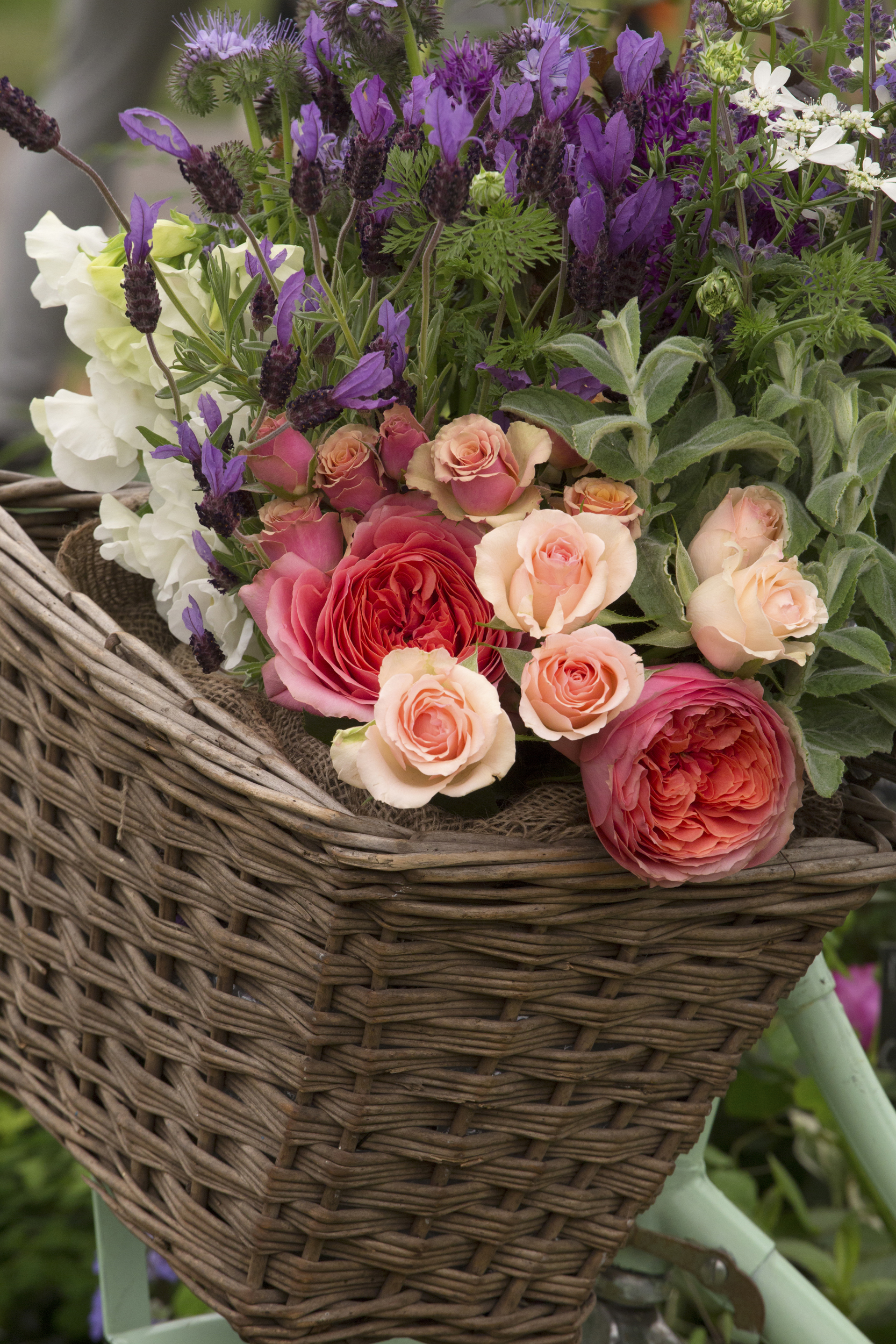
Homegrown roses can make beautiful posies and floral displays
Rose gardens to visit
Mottisfont Abbey – walled rose garden with one of the best old rose National Collections. Romsey, Hampshire SO51 0LP.
David Austin Roses – display garden with the largest collection of David Austin roses, and plant centre. Albrighton, Wolverhampton WV7 3HB.
Coughton Court – rose labyrinth with 200 varieties. Alcester B49 5JA, Warwickshire.
Sissinghurst Castle – famous white garden with roses and herbaceous. Cranbrook, Kent TN17 2AB.
RHS Garden – modern roses in the Queen Mother’s garden. Rosemoor, Torrington, Devon EX38 8PH.
Read more about garden design:
- How to create a cottage garden
- How to choose plants for your garden
- Beautiful garden border ideas